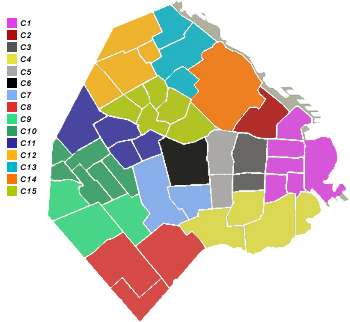Communes of Buenos Aires
The city of Buenos Aires is administratively divided into fifteen comunas,[1] unlike the rest of Argentina where the second order administrative division is departamentos, or the Province of Buenos Aires which is subdivided into partidos.[2] Each comuna (commune) of the city encompasses one or more neighbourhoods (barrios), which are represented in the respective community centres for administrative purposes.[3]
The division by comuna was instituted by the 1996 Constitution of the City of Buenos Aires[4] and modified in 2005 by Law #1777.[5] The law was again modified in 2008,[6] 2011,[7] and 2013[8]
The comuna are serially numbered. They are listed below in numerical order together with their constituent neighbourhoods.[9]

- Comuna 1: Puerto Madero, San Nicolás, Retiro, Monserrat, San Telmo, and Constitución
- Comuna 2: Recoleta
- Comuna 3: Balvanera and San Cristóbal
- Comuna 4: La Boca, Barracas, Parque Patricios, and Nueva Pompeya
- Comuna 5: Almagro and Boedo
- Comuna 6: Caballito
- Comuna 7: Flores and Parque Chacabuco
- Comuna 8: Villa Soldati, Villa Lugano, and Villa Riachuelo
- Comuna 9: Parque Avellaneda, Mataderos, and Liniers
- Comuna 10: Villa Luro, Vélez Sársfield, Floresta, Monte Castro, Villa Real, and Versalles
- Comuna 11: Villa Devoto, Villa del Parque, Villa Santa Rita, and Villa General Mitre
- Comuna 12: Villa Pueyrredón, Villa Urquiza, Coghlan, and Saavedra
- Comuna 13: Núñez, Belgrano, and Colegiales
- Comuna 14: Palermo
- Comuna 15: Villa Ortúzar, Chacarita, Villa Crespo, La Paternal, Agronomía and Parque Chas.
Notes and references
- ↑ "Cuadro P1-P. Ciudad Autónoma de Buenos Aires. Población total y variación intercensal absoluta y relativa por comuna. Años 2001-2010" (PDF). Censo 2010 (in Spanish). El Instituto Nacional de Estadística y Censos. Archived (PDF) from the original on 8 April 2014.
- ↑ "Cartografía y códigos geográficos del Sistema Estadístico Nacional; Definiciones: Jurisdicciones de segundo orden". Unidades Geoestadísticas (in Spanish). El Instituto Nacional de Estadística y Censos. Archived from the original on 18 March 2014.
- ↑ "Decreto Nº 251/14". BOCBA 4426 Publ. 27/06/2014 (in Spanish). La Legislatura de la Ciudad Autónoma de Buenos Aires. Archived from the original on 3 July 2015.
- ↑ Title 6 "Título Sexto - Comunas" (in Spanish). La Legislatura de la Ciudad Autónoma de Buenos Aires. Archived from the original on 31 August 2010.
- ↑ "Ley Orgánica de Comunas, Nº 1777". La Legislatura de la Ciudad Autónoma de Buenos Aires. 1 September 2005. Archived from the original on 23 December 2007.
- ↑ Ley Orgánica de Comunas, Nº 2650
- ↑ Nº 3802 and Nº 4013 of 2011
- ↑ Nº 4630 of 2013
- ↑ "Notas aclaratorias referidas a la división político-territorial y político-administrativa en las publicaciones censales" (PDF) (in Spanish). El Instituto Nacional de Estadística y Censos. 2012. p. 2. Archived (PDF) from the original on 3 June 2014.
This article is issued from Wikipedia - version of the 9/15/2016. The text is available under the Creative Commons Attribution/Share Alike but additional terms may apply for the media files.